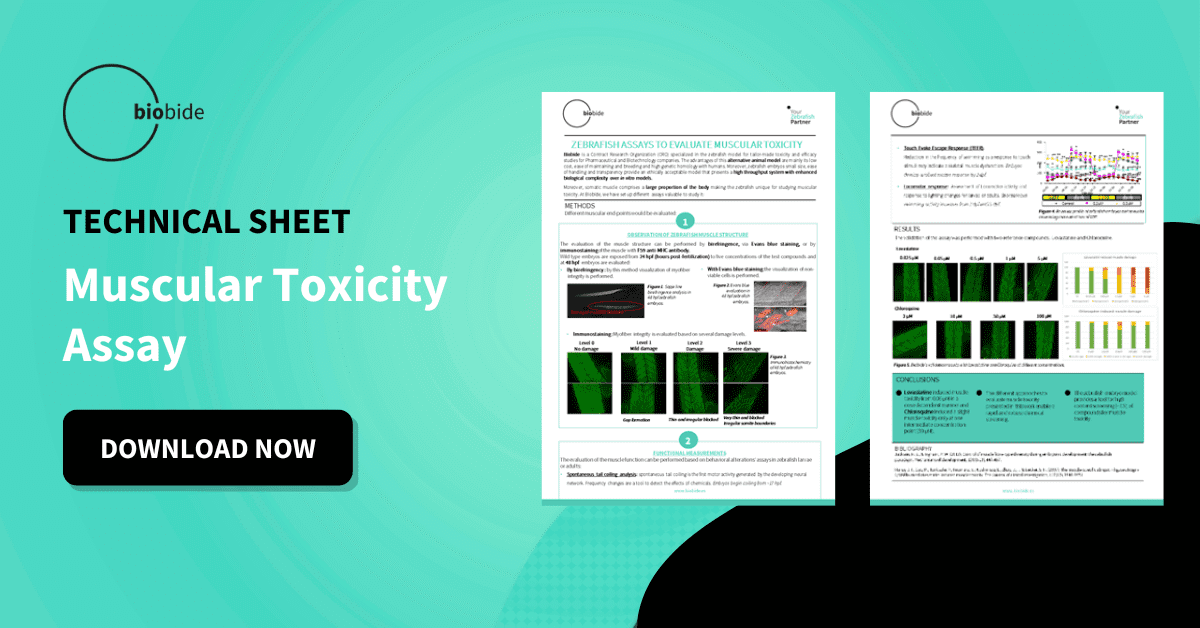Muscular diseases encompass a broad range of debilitating conditions that affect muscle structure and function, resulting in a significant impairment in mobility and overall quality of life. These diseases, which embrace muscular dystrophies, myopathies, and other neuromuscular disorders, pose substantial challenges for patients, their families, and the healthcare system due to the high dependence on the affected patients, caregivers, and healthcare professionals. Moreover, many of these diseases are severely deteriorating and the treatments available are not effective. Therefore, it is crucial to develop new successful treatments for these pathologies, to do so requires a deep understanding of their underlying physiopathology. It is of research importance to have reliable and representative disease models.
What are Muscular Diseases?
Muscular diseases are a diverse group of pathologies affecting the structure, function, and overall well-being of the muscles in the human body. Their nature is very diverse due to their different origin and pathophysiology; and can be divided into primary muscle diseases, if the affection derives in the muscle, or secondary muscle diseases, if the muscular affection is a consequence of a malfunction in another organ or tissue. They commonly share symptoms such as muscle weakness, muscle loss, impaired mobility, pain, and fatigue. Other factors such as the age when the person first started with symptoms, severity of the pathology, or outcome, on the contrary, vary greatly between them.
Primary muscular diseases are usually dystrophies, normally caused by mutations in genes involved in muscle function or by immune system disorders. Secondary muscular diseases, mainly, have neuronal involvement and are caused by alterations in the nervous system that prevent proper muscle function, normally, affecting peripheral nerves or nerve-muscular junctions.

Among the most common muscular diseases stand out the following:
- Duchenne Muscular Dystrophy (DMD) is one of the most relevant and severe muscular dystrophies, characterized by progressive muscle weakness and degeneration. It is caused by mutations in the dystrophin gene, which plays a critical role in maintaining the structural integrity of muscle fibers.
- Spinal Muscular Atrophy (SMA) is a genetic disease involving the deterioration of motor neurons, leading to muscle weakness and atrophy.
- Myasthenia Gravis (MG) is an autoimmune disease in which antibodies interfere with neuromuscular junction, producing skeletal muscle weakness.
- Amyotrophic Lateral Sclerosis (ALS) is a fatal neurodegenerative disease characterized by the progressive loss of motor neurons that control voluntary muscles causing muscle weakness.
- Polymyositis and Dermatomyositis are idiopathic inflammatory myopathies characterized by muscle inflammation, weakness, and, in the case of dermatomyositis, skin rashes. These conditions are thought to be autoimmune although the molecular mechanism underlying these diseases is not well understood.
Muscular diseases can affect individuals of all ages, from infants to older adults. Some muscular diseases, like DMD, typically manifest early in childhood, while others may have a later onset in adolescence or adulthood. The age of onset, disease progression, and severity can vary, even within the same disease, resulting in a broad spectrum of clinical presentations, outcomes, and even life expectancy.
The treatment of these diseases is usually symptomatic, with modest effectivity, due to the genetic involvement in most of them. Therefore, understanding the underlying mechanisms of muscular diseases is vital for developing effective diagnostic methods, treatments, and interventions. Researchers and clinicians employ a multidisciplinary approach when studying these complex diseases, involving genetics, molecular biology, imaging techniques, and/or clinical evaluations.
Therefore, muscular diseases pose a mindboggling challenge, and improvements in disease management and the development of new therapies are tremendously relevant to improve the prognosis and the quality of life of affected patients.
In this sense, animal models, including mice, dogs, and non-human primates, have contributed immensely to our understanding of muscular diseases and the development of experimental treatments. These models help unravel disease mechanisms, test potential interventions, and provide insights into the complex interactions between muscles, nerves, and other systems, before going to Clinical Trials in humans. More important due to the limited number of patients enrolled in the Clinical trials, due to the low incidence of those diseases in general. However, animal experimentation in highly evolved organisms such as mammals presents limitations such as sky-high costs and being extremely time and cost-demanding. Above all, they come with vast baggage of important ethical concerns. To overcome these limitations, huge efforts have been employed in the development and validation of New Approach Methodologies (NAMs) to diminish the dependency on animal experimentation. One of the most relevant NAMs is the zebrafish, a small vertebrate that presents great benefits over mammals and is ideal for modeling muscular pathologies and for muscle toxicology testing.
How can Zebrafish models benefit Muscular Diseases?
Zebrafish is an ideal NAM because of its excellent quantitative and qualitative results and cost-effectiveness as well as compliance with high ethical standards and 3R´s. In relation to the cost-effectiveness of the model, zebrafish is a small and easy-to-maintain fish that present high reproductivity and fast growth. Not only the advantage of having a small size and fast organogenesis, but they also present highly functional organs in less than 5 days, allowing High Content Screenings (HCS) after just a few days after fertilization. According to ethical standards, the zebrafish model permits the use of embryos instead of adult animals which is in line with the research animal care policy, represented by the 3Rs Principles (Replacement, Reduction and Refinement). Moreover, zebrafish are an ideal model for muscular diseases due to their transparent body in their larval stage, allowing direct visualization of the somitic muscle of the tail that comprises a large proportion of the body. Zebrafish have similar molecular and histological features compared to mammals, with nearly identical ultrastructural levels, preserved glycoprotein complex, and excitation-contraction coupling machinery functionally and structurally. In addition, the genetic background of the animal presents a high homology to humans with very similar not only muscle systems, but also the nervous system, which offers reliable results. Also, its genome is well-known and can be easily genetically modified to model the majority of genetic-based muscular diseases. Many muscular disease models have been developed in zebrafish including DMD, SMA, ALS, and MG among others.
All these characteristics make the zebrafish model a highly valuable tool for testing new therapeutic interventions such as Gene Therapy or Targeted Therapy in the different muscular disease models and, also, for the assessment of muscular toxicity of new therapies, especially the ones administrated intramuscularly, in the Early Discovery and Development, where cots and the capacity of testing a high number of candidates are crucial.
Biobide’s muscular toxicity assay
Biobide has set up an HCS muscular toxicity assay that allows the evaluation of the muscular integrity and mobility difficulties of the zebrafish larvae exposed to a compound, the MuscleTox Assay. This approach can be also used for measuring the efficacy of new treatments in zebrafish muscle disease models. Thus, Biobide has obtained a vast array of muscular disease models such as a DMD model based on a mutation in the dystrophin gene and ALS models SOD1, with mutations in the superoxide dismutase 1 gene, or C9orf72, produced by a gene sequence repetition. In addition, Biobide offers tailor-made solutions with the possibility of obtaining other disease models thanks to the innovative vast gene editing technologies. The MuscleTox Assay is based on the observation of zebrafish larvae below 6 days post-fertilization, and analyzes the muscle structure and developing functional measurements based on tail movements and swimming characteristics.
Muscle Structure is observed by:
- Birefringence Assay: based on the refractive differences of light when crossing an anisotropic material. The highly ordered muscular pattern of zebrafish skeletal muscle gives birefringence properties that are altered when the muscular pattern is compromised. Thus, this assay allows the evaluation of myofiber integrity.
- Immunofluorescence Assay: permits the assessment of the muscular fiber structural integrity by immunofluorescence staining with different antibodies, which bind and stains muscle fibers. This technique allows good visualization of the muscular fiber pattern.
- Evans-blue staining Assay: This staining gives information about the myofiber integrity of the muscle as it is only permeable to non-viable muscle cells.
Functional Measurements:
- Spontaneous Tail´s Coilings Assay: the measurement of the spontaneous tail´s coiling, which is the first motor activity generated by the developing neural network. Thus, alterations of the muscular system can affect this tail movement.
- Touch Evoke Escape Response (TEER) Assay: This assay evaluates the reduction in the frequency of swimming as a response to touch stimuli, that may indicate a skeletal muscle dysfunction.
- Locomotor Response Assay: the assessment of locomotor activity in response to lighting stimuli. Being the most typical one the Ligh /Dark transition Test.
These assays grant a deep analysis of the muscular structure and function as well as provide reliable information on the overall muscular integrity. This enables the detection of possible toxic effects of drugs on the muscular system or a complete evaluation of the muscular system in a muscular disease model after the application of a new treatment, to evaluate its efficacy.
Conclusions
Muscular diseases represent a colossal clinical challenge due to poor treatment efficacy and the high impact on life quality, not only on the patients but also on the caregivers and families of the affected patients. Therefore, it is compulsory to develop effective therapeutic alternatives that directly target the molecular mechanisms underlying these diseases. To do so, it is imperative to study in detail the pathophysiology of these conditions on reliable animal models.
In the past
years, the development of NAMs allowed faster and more cost-effective methods for research or drug testing with higher ethical standards compliance. Among them, the zebrafish model has become one of the most successful and, also, useful for muscular disease evaluations as it permits direct visualization of the muscle fibers, enabling a deep study of changes in the fiber organization, integrity, and functional evaluations, based on visual analysis and swimming patterns studies. Besides, it offers a competitive and cost-effective possibility of performing HCS assays, and the opportunity to easily genetically or pharmacologically generate disease models.
In this sense, Biobide, the worldwide leading zebrafish CRO, has developed an HCS Muscular Toxicity and Efficacy Assays to accurately measure muscle integrity and functionality. In addition, having different muscular disease zebrafish models (DMD or ALS) and highly qualified personnel that can generate tailor-made solutions allow Biobide to offer high-quality muscular disease studies and in order to advance in the research of new therapeutic alternatives for these challenging pathologies.
Sources
- Mynard JP, Valen-Sendstad K. A unified method for estimating pressure losses at vascular junctions. Int J Numer Method Biomed Eng. 2015 Jul;31(7):e02717.
- https://doi: 10.1002/cnm.2717. Epub 2015 Apr 29. PMID: 25833463.
- Morrison B. M. (2016). Neuromuscular Diseases. Seminars in neurology, 36(5), 409–418. https://doi.org/10.1055/s-0036-1586263.
- Mercuri, E., Sumner, C. J., Muntoni, F., Darras, B. T., & Finkel, R. S. (2022). Spinal muscular atrophy. Nature reviews. Disease primers, 8(1), 52. https://doi.org/10.1038/s41572-022-00380-8.
- Shieh P. B. (2013). Muscular dystrophies and other genetic myopathies. Neurologic clinics, 31(4), 1009–1029. https://doi.org/10.1016/j.ncl.2013.04.004.
- Bhatt J. M. (2016). The Epidemiology of Neuromuscular Diseases. Neurologic clinics, 34(4), 999–1021. https://doi.org/10.1016/j.ncl.2016.06.017
- Gilhus N. E. (2016). Myasthenia Gravis. The New England journal of medicine, 375(26), 2570–2581. https://doi.org/10.1056/NEJMra1602678.
- Li, M., Hromowyk, K. J., Amacher, S. L., & Currie, P. D. (2017). Muscular dystrophy modeling in zebrafish. Methods in cell biology, 138, 347–380. https://doi.org/10.1016/bs.mcb.2016.11.004.
- Gois, A. M., Mendonça, D. M. F., Freire, M. A. M., & Santos, J. R. (2020). IN VITRO AND IN VIVO MODELS OF AMYOTROPHIC LATERAL SCLEROSIS: AN UPDATED OVERVIEW. Brain research bulletin, 159, 32–43. https://doi.org/10.1016/j.brainresbull.2020.03.012.
- Singh, J., & Patten, S. A. (2022). Modeling neuromuscular diseases in zebrafish. Frontiers in molecular neuroscience, 15, 1054573. https://doi.org/10.3389/fnmol.2022.1054573.





